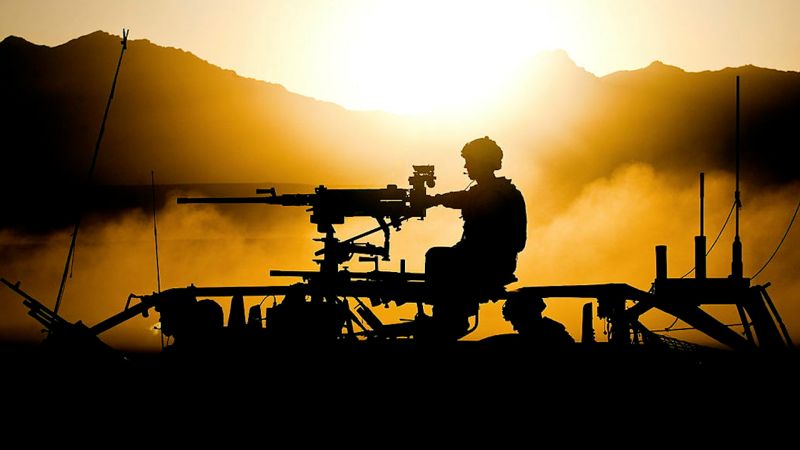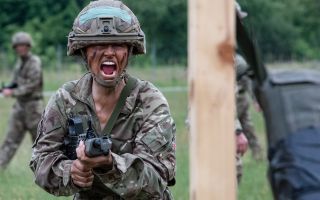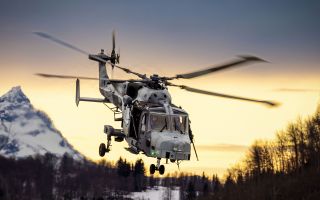
Sitrep: What would a boots-on-the-ground security force in Ukraine look like?

Prime Minister Sir Kier Starmer said on 17 February that the UK stands ready to send troops to Ukraine if there is a lasting peace agreement.
The Russian government has stated repeatedly in the last week it will not allow any troops from Nato countries to be a peacekeeping force in Ukraine.
Also, one of the main reasons for their 'special military operation' was to prevent Ukraine from becoming part of Nato.
Defence Secretary John Healey said planning for British troops to deploy to Ukraine is underway.
He also repeated the Prime Minister's words that the US must provide a security guarantee, a backstop, "because it is only the US that can provide the deterrent to Putin that will prevent him attacking again".
General Lord Richard Dannatt, former Chief of the General Staff, discussed the differences between a peacekeeping force and a stabilisation force on the latest episode BFBS Sitrep – which analyses the top defence stories of the week and is available wherever you get your podcasts.
Peacekeeping forces are used in a benign situation in a surveillance and monitoring role – which works if the warring parties are willing participants.
An example of this is the United Nations Protection Force (UNPROFOR) in Bosnia and Croatia from 1992 to 1995.
It then changed from a peacekeeping force to a Nato-led stabilisation or peace implementation force, with stronger rules of engagement.
According to Lord Dannatt, the length of the Ukrainian frontlines at 1,000km would need a very large force and include American enablers.
He thinks that without a US 'backstop' the operation would not be possible.
However, rather than a large force, there might also be other more technical solutions, such as monitoring the frontlines using surveillance devices like drones and satellites.
It is also possible any force would not be stationed on the present frontlines but would be mobile to reassure the Ukrainian population by its presence.
Lord Dannatt believes the likelihood of an international force being deployed into Ukraine is low and the Russians won't accept it anyway.
Professor Michael Clarke, former Director-General of RUSI, told Sitrep he believes the Prime Minister will say to President Trump when they meet in Washington on 27 February that if the US can agree on a settlement in Ukraine, then the UK is willing to help enforce it, but the US will need to help with enablers.
Prof Clarke said this is because the UK is willing to help as it wants the US peace plan to work and the fighting to stop.
He believes the Ukrainian priorities are to have guarantees for their security in return for the 20% of their territory they will likely have to give up.
He thinks a more realistic proposal to a stabilisation force on the ground would be an air policing zone. In air power, the Europeans are much stronger than the Russians.
He says such a force would need to have sufficient rules of engagement that they could defend Ukrainian targets from attack.
However, this scenario would increase the likelihood of direct conflict between Europe's forces and Russia's.
Lord Dannatt argues that diverting large numbers of European forces to protect Ukraine could leave countries further north, such as Poland and the Baltic states, less protected.
This argument has also been used recently by Defence Select Committee MP Mike Martin.
Lord Dannatt says any possible stabilisation force in Ukraine could need up to 100,000 troops given the size of the confrontation line.
So, hypothetically, if 10 European countries deployed troops then the UK might need to send 10,000 troops.
Using the principle of a one-in-three unit rotation, that would require up to 30,000 troops out of the UK Army currently sized at approximately 70,000 personnel.
In fact, in Afghanistan, the rotation was one-in-four six-month tours.
Also, the duration of the deployment could be 20 to 30 years. For example, US troops have been in Korea since the 1950s and Nato forces have been in Kosovo for the last 25 years.
Once deployed, those troops would not be available for any other purposes.
Alternatively, if the force deployed was a point reassurance force of approximately eight brigades of 5,000 troops each, then the total would be about 40,000 strong.
This force would be able to move to potential trouble spots quickly.
Prof Clarke says command and control of any force and clarity of rules of engagement would be essential.
What flag such a force would come under and the command and control arrangements would all need to be established.
President Putin says he won't accept Nato. A European Union (EU) force is a possibility, but the UK isn't inside the EU.
A United Nations (UN) force is a possibility. These would be non-Nato or EU troops.
Countries which provide peacekeepers to operations are paid more than $1,000 per day for each soldier by the UN. However, if there isn't a firm enough ceasefire, many countries will be unwilling to contribute troops.
General Lord David Richards, former Chief of the Defence Staff, argues that an external force is not required and that what is needed is greater support for Ukraine militarily so they will be too strong to attack.
This could be the most pragmatic solution, which also avoids the potential for direct Nato-Russian confrontation. He says the Ukrainians have a proven ability, with our backing, to defend themselves.
Lord Dannatt thinks the Russians have nearly one million casualties and that the damage to their economy means President Putin is ready for a ceasefire.
He sees parallels with the Korean War, where the fighting stopped in 1953 but there was no peace agreement.
According to Prof Clarke, US enablers, if provided, would include air transportation, heavy lift of equipment, plus an intelligence surveillance and reconnaissance capability.
The 'backstop' means they would be prepared to take on the preservation of the peace deal should it start to slip away.
He believes a US administration would not accept seeing the fighting resume during a Trump presidency, as that would represent a failure to his administration.
Prof Clarkes also believes the Russians want other 'sweeteners' to stop attacking Ukraine. These could include withdrawing US troops from the newer Nato members in eastern Europe.
He thinks this could be dangerous as the Russians believe Article 5 no longer exists or, in other words, that Nato countries would not support each other if pressed.
This would make a European-only force in Poland or the Baltic states much more vulnerable to Russian attack.
Lord Dannatt comments that, although the PM Kier Starmer says the UK is ready and willing to send troops, "he might be willing – but we're not ready".
He says the UK has insufficient numbers of troops, tanks, armoured vehicles, artillery and air defence to maintain a significant force in Ukraine in the long term.
You can listen to Sitrep wherever you get your podcasts, including on the Forces News YouTube channel.









